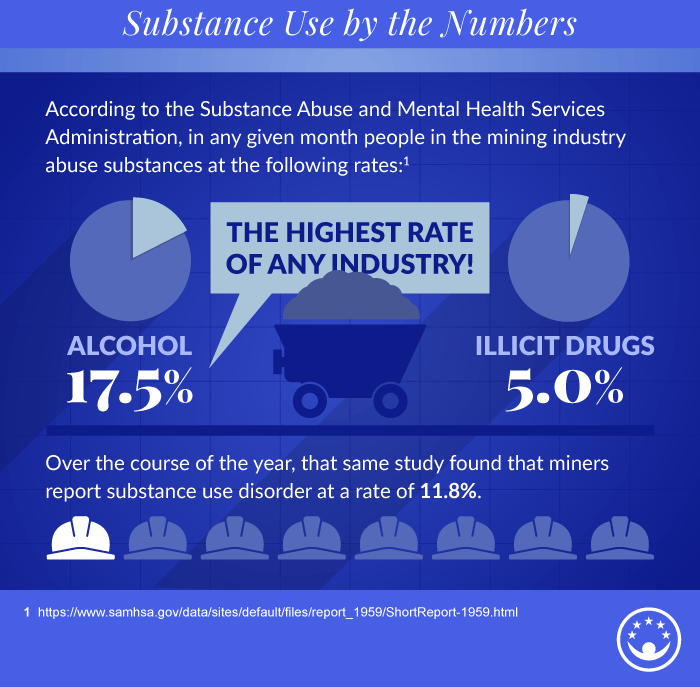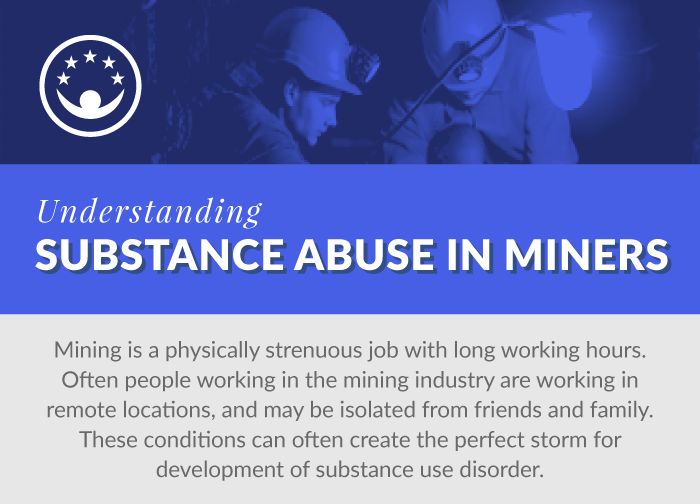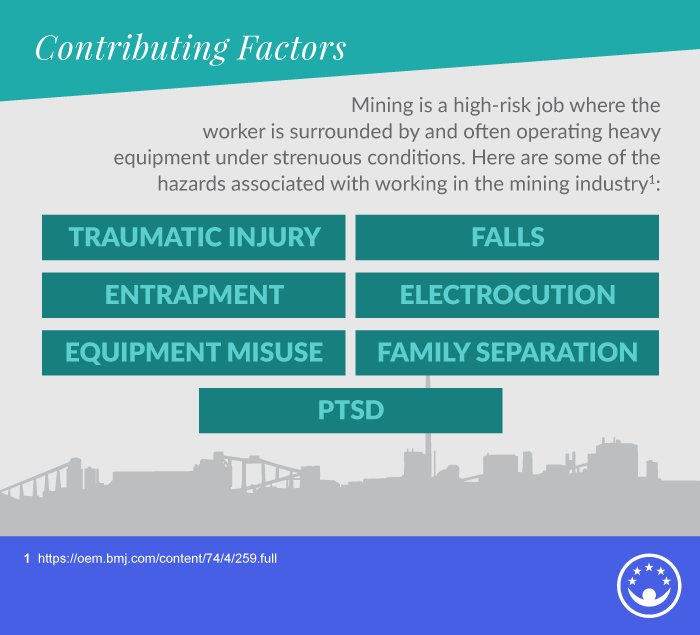The Mining Industry and Addiction
The mining industry can put a lot of pressure on its employees, including heavy workloads and hazardous conditions. This can cause workers to turn to substances for coping with high levels of physical pain, emotional turmoil, and mental stress.
Substance Abuse in the Mining Industry
The extent of substance abuse among workers in the mining industry is detailed in a recent report released by the Substance Abuse and Mental Health Services Administration. During their analysis, the authors of this report compared illicit drug use and heavy alcohol use across various industry sectors in the United States. Some of the study findings pertaining to workers within the mining industry include:1-2
- 17.5% of workers reported heavy alcohol use within the past month
- 5% of workers reported illicit drug use within the past month
- 11.8% of workers reported drug or alcohol dependence during the past year
- 1% of workers reported an opioid use disorder
The rate of heavy alcohol use in the mining industry is higher than in any other industry and is more than double the overall rate among all full-time workers in the United States. The rate of miners that reported a substance use disorder within the past year was also the third highest of all industries. About 1 in 100 workers in the mining industry has an opioid use disorder, a higher than average rate according to a report from the National Safety Council.2
The high rate of opioid abuse and addiction among miners is associated with an increased risk of overdose and death. In fact, workers in the extraction industry (mining, quarrying, and oil and gas extraction) have the highest mortality rates from natural and semisynthetic opioid–related overdose deaths and the second highest mortality rates from synthetic opioid-related overdose deaths, according to a study of occupations associated with drug overdose deaths based on mortality data from the National Occupational Mortality Surveillance system.3

Factors Influencing Addiction in the Mining Industry
There are many factors that contribute to the risk for addiction. We know through studies in families and twins that genetics is the most important risk factor for the development of substance abuse,4 but there are also several environmental factors that contribute to one’s risk for addiction. These can include:5
- Parental monitoring
- Peer pressure
- Socioeconomic status
- Type of substance
- Stress
- Drug availability
- Occupation
The mining occupation is particularly conducive to substance abuse for a few reasons. Mining is an extremely stressful job, and many workers may turn to alcohol or drugs to cope with this stress. Mining is also a physically demanding job, and the constant strain on the body can lead to injuries. It is not surprising that so many workers resort to self-medication and abuse of prescription painkillers, such as opioids, in order to get through their workday.2
Many addicted miners develop increased tolerances and eventually move onto stronger opioids such as heroin, resulting in even more deadly consequences. This is the case in West Virginia, where the coal mining industry accounts for 2% of the state’s total employment and heroin and opioid overdoses are twice the national average.3,6
Alcohol is by far the most commonly abused substance in the mining industry. Mining is a male-dominated industry characterized by grueling workloads, high stress, and extremely hazardous conditions. These factors likely play an important role in the rampant abuse of alcohol among miners, as research has shown that work conditions are important risk factors for alcohol misuse in male dominated industries.7
The rostering work arrangement in the mining industry may also contribute to the problem of substance abuse among miners. In a roster system, which is designed to increase productivity and reduce down-time through fewer shift changeovers, miners usually work 12 hours shifts for 2-3 weeks, followed by one week of leave.8
These long blocks of time away from the workplace, in addition to isolation from society, separation from loved ones, boredom, a lack of entertainment options, peer-pressure from co-workers, physical pain, and mental distress, contribute to create an environment where heavy alcohol consumption and drug use are not only accepted but encouraged.
Treatment
Alcohol and opioid abuse prevention strategies are needed to target workers in the high-risk industry of mining. Employers in the mining industry also need to address workplace drinking norms and painkiller misuse, reduce job workloads and stress, improve worker support, and provide adequate access to addiction treatment.
Sources
- Bush, D.M., & Lipari, R.N. (2015). Substance Use and Substance Use Disorder by Industry.
- National Safety Council. (2017). A Substance Use Cost Calculator for Employer.
- Centers for Disease Control and Prevention. (2018). Occupational Patterns in Unintentional and Undetermined Drug-Involved and Opioid-Involved Overdose Deaths-United States, 2007-2012.
- Ducci, F. & Goldman, D. (2008). Genetic approaches to addiction: genes and alcohol. Addiction, 103(9), 1414-1428.
- Vink, J.M. (2016). Genetics of Addiction: Future Focus on Gene × Environment Interaction? Journal of Studies on Alcohol and Drugs, 77(5), 684-687.
- U.S. Department of Energy. (2017). U.S. Energy and Employment Report.
- Roche, A.M., Lee, N.K., Battams, S., Fischer, J.A., Cameron, J., & McEntee, A. (2015). Alcohol use among workers in male-dominated industries: A systematic review of risk factors. Safety Science, 78, 124-141.
- Baker, A., Heiler, K., & Ferguson, S.A. (2003). The impact of roster changes on absenteeism and incident frequency in an Australian coal mine. Occupational and Environmental Medicine, 60, 43-49.



